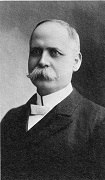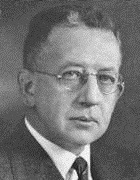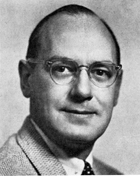HISTORY OF THE DEPARTMENT OF NEUROLOGY
The Division of Neurology of the department of Psychiatry and Neurology at the University of Minnesota in 1946 was the legacy of four professors who directed it since 1888. Each successive leader extended the aims and achievements of his predecessor. The early faculty was entirely voluntary. Later, there was one, then more full-time faculty supplemented by several part-time and voluntary clinical teachers all of whom contributed considerably to the development and reputation of the department. After 1950 an increasing number of full time faculty joined the division, later to become a full department.
Most of the historical sketch of the department of Neurology was prepared by Dr. Royal C. Gray and published in J. Arthur Myer's book, Masters of Medicine. Modified here by Dr. William R. Kennedy. To better show the development of the department. I (WRK) inserted a short description of the contribution of Dr. Donald Hastings to the development of the Neurology Department between the third and fourth members, Dr. McKinley and Dr. Baker.
C, (Charles) Eugene Riggs
Born in Williams County, April 26, 1853; son of Charles and Annie Northcraft Riggs; married Mabel Elizabeth Pratt. He received a bachelor of arts; and Master of Arts degrees from Ohio Wesleyan University in 1877 and studied medicine in the office of his physician brother for two years followed by one formal year in the Medical College of Nashville, Tennessee. He graduated in 1880 from the College of Physicians and Surgeons, Baltimore and completed one year senior internship at Woman's Hospital in Baltimore, after post graduate courses at New York, London, Edinburgh and Paris he came to St. Paul and engaged in general practice in 1881. In 1882, he became professor of mental and nervous diseases in the St. Paul Medical College. Thus began the neurological adventure of the first neurologist in the Northwest. When the University of Minnesota College Hospital was organized in 1888, Dr. Riggs became its professor of nervous diseases. He was interested in both neurology and psychiatry and in 1909, largely through his efforts; the Minnesota Voluntary Commitment and Detention laws were enacted. After the reorganization of the faculty by President Vincent he resigned from the faculty after 25 years of gratuitous service and became professor emeritus of nervous and mental diseases. He was a founder and first president of the Minnesota Neurological Society in 1909 and a member of the American Neurological Association, American Medico Psychological Association and American Medical association. He is pictured with other members of the American Neurological Association in 1896.
Arthur S. Hamilton
Arthur S. Hamilton was born November 28, 1872 in Wyoming, Iowa of Scott Hamilton and Susanna P. Boyle. He was awarded the degree of doctor of medicine by the University of Pennsylvania in 1897. He was assistant physician at the Independence, Iowa State Hospital for seven years. In 1904, he entered the private practice of neurology and psychiatry in Minneapolis. Dr. Hamilton was appointed assistant in pathology of the nervous system, Department of Pathology and Bacteriology, at the University, College of Medicine and Surgery in 1905. In 1906, Dr. Hamilton became instructor in pathology of the nervous system and in sole charge of the course on pathology of the nervous system. Thus began the dichotomy of Neuropathology. In 1907, Dr. Hamilton was also named clinical instructor in nervous and mental diseases, the first faculty member to hold a dual appointment. He conducted a clinic at the University Free Dispensary near Seven Corners in Minneapolis. Dr. Hamilton became assistant professor of nervous and mental diseases in 1912, associate professor and director of the Division of Nervous and Mental Diseases in 1913, and professor and director of the division in 1915. He was a founder and first secretary of the Minnesota Neurological Society in 1909 and of the Central Neuropsychiatric Association in 1922. He had a great interest in medical history and medical literature. His breadth of knowledge, clear analytic thinking, careful technique, gentleness with patients and consideration for the younger colleagues' opinions constituted in him the nearly ideal combination for an adviser and preceptor of the more advanced students. Dr. Hamilton was an early and forceful advocate of postgraduate medical education. He contributed of his time and private funds to further this program. A number of teaching fellows had the good fortune to come under his tutelage. His two outstanding students were Henry W. Woltman, who became chairman of the Department of Neurology and Psychiatry at the Mayo Clinic in 1930, and J. Charnley McKinley, who succeeded Dr. Hamilton in 1935.
J. (John) Charnley McKinley
J. (John) Charnley McKinley earned the doctor of medicine degree from the University of Minnesota in 1919. Continuing as a teaching fellow, in 1921 he received a doctor of philosophy degree in nervous and mental diseases. His teaching and research abilities were quite evident and, with Dr. Hamilton's hearty endorsement, he then became assistant professor of nervous and mental diseases. He was the first full-time faculty member in the field of neurology. In 1925, he was advanced to associate professor. In 1928, he received a Guggenheim Fellowship and studied neuropathology and neurology at the Universities of Breslau and Munich , Germany . Upon his return to the Medical School in 1929, he became professor of nervous and mental diseases. In 1934, he was made administrative head of the Department of Medicine. He was president of the Central Neuropsychiatric Association in 1938. He was a director of the American Board of Psychiatry and Neurology from 1941 to 1945.
Dr. McKinley did extensive research on muscle tonus and in poliomyelitis. He compounded a vaccine for active immunization against poliomyelitis; and offered a proposal of wholesale passive immunization against poliomyelitis epidemics. He studied the mid-brain nuclei in post encephalitic paralysis agitans and did meticulous stains and cell counts of these areas.
A methodical teacher and author, McKinley was precise in his lecturing and writing. His scientific watchwords were accuracy and honesty. Early in his career in 1915, he prepared Sensory Nerve Topography charts, showing the segmental and radicular distributions, and companion Motor Function charts. These charts, which he carefully constructed from a composite of all the anatomy and related texts in print, have been reproduced in numerous standard text-books and are still recognized as the most usable and accurate neurologic information of its kind extant. In 1939, he edited An Outline of Neuropsychiatry, A compendium and ready reference book for student and practitioner. This Outline went through four editions, the last one in 1944, and was widely used for many years. Dr. McKinley was convinced that most disasters in politics, crime and the like are due to mental disorders that should be detected before catastrophe occurred. He was influential in the enactment of the Minnesota Psychopathic Personality Law. Inasmuch as no device was available for quickly screening such personalities from any group of individuals, in collaboration with Dr. Starke R. Hathaway, he developed the Minnesota Multiphasic Personality Inventory. This is a psychometric device for the more objective evaluation of personality, especially in psychiatric terms. An account was first published in 1942 and because of the overwhelming demand on the local facilities for manufacture; it was released to the Psychological Corporation in New York for manufacture and distribution. It has been used routinely by hundreds of private clinics and individual doctors as well as large organizations. In 1942, McKinley was commissioned to edit a three volume text on Clinical Neurology, planned to be a complete treatise on the subject, and he arranged with 30 nationally known neurologists to contribute chapters. The edition was well under way when it was stayed by situations incident to World War II. Dr. McKinley was disabled by a stroke in 1946 and was succeeded by Dr. A.B. Baker.
DEPARTMENT OF NEUROPSYCHIATRY ESTABLISHED
After serving as chief of the Department of Internal Medicine for 10 years, Dr. McKinley attained a goal he had long sought, namely a psychopathic unit. He had developed the plan and oversaw every detail of construction of the unit. When it was completed in 1937, nothing had been omitted that would insure the safety of his mentally ill patients as well as those who cared for them. After this unit was established, his next goal was to develop a Department of Neuropsychiatry. This was accomplished in 1943 when McKinley became head of the new department. Thereafter he limited his activities to that field. However, on May II, 1945 when he was at the height of his contributions and influence, he had a cerebral hemorrhage. Like his immediate predecessor Dr. Hamilton, he was also totally disabled for five years before he died on January 3, 1950.
Dr. A. B. Baker said to me (Dr. Royal Gray) "Dr. McKinley's most outstanding quality was his total lack of personal selfishness." He was always willing and anxious to help and guide the academic and scientific development of his staff and colleagues and took great pride in their achievement. In fact, one of the greatest satisfactions one could obtain was the privilege and pleasure of being able to discuss problems with him and become infected with his enthusiasm and encouragement. Dr. McKinley had not completed his three-volume text on Clinical Neurology. However, Dr. Baker continued with the manuscript in 1945 and published it in 1955 with the inscription "Dedicated to a great teacher of Medical Neurology, Dr. John Charnley McKinley." When it was determined that Dr. McKinley's incapacity would be permanent, a search committee made a thorough survey for his successor. The unanimous choice was Donald W. Hastings.
Donald Hastings
Dr. Donald W. Hastings wrote the following description of the Department of Psychiatry and Neurology. The Department is composed of four major divisions: adult psychiatry, child psychiatry, neurology and clinical psychology. Each of the divisions, with the exception of clinical psychology, carries direct patient responsibility on its hospital and out-patient services. Clinical psychology occupies a consultant role in patient care. The experiences during World War II brought home to the nation the importance of the mental health of its citizens. The numbers of men who were rejected for psychiatric reasons, or later discharged from active duty for psychiatric disability, were appalling. One of the effects of this phenomenon was to see the medical schools of the country place an added importance on their departments of psychiatry, with particular reference to the training of the medical student. This development occurred at Minnesota at the close of the war. My (Hastings) arrival at the University of Minnesota, March 1, 1946, coincided with the developments mentioned above. By coincidence, March 1, 1946, also saw the start of a two-week pilot course, "Teaching Psychotherapeutic Medicine to the General Physician." This postgraduate session, attended by 25 Minnesota general physicians and subsidized by the Commonwealth Fund, established a pattern for similar courses soon to be conducted by most major teaching centers over the country. It was symbolic of the recognition of the importance of the general physician as the first line of defense within his own community in dealing with emotional problems. As of March 1, 1946, the full-time departmental faculty was small. Dr. A. B. Baker, primarily a neurologist, Dr. B. C. Schiele, primarily a psychiatrist, and Dr. S. R. Hathaway, clinical psychologist were the three senior faculty members in addition to the new chairman. There were three residents. The department in 1946 was termed the "Department of Neuropsychiatry." Because the two specialties were by now quite separate in their clinical methods and techniques, plans were made for two separate divisions, i.e., the Division of Psychiatry and the Division of Neurology, the latter headed by Dr. Baker. This change was effected in the summer of 1946, a change also in keeping with the national pattern that was evolving. Neurology and Psychiatry became separate departments within the Medical School in 1968-1969.
Laboratory space was at a premium and no significant expansion of research other than that of a strictly clinical nature done on the wards or in the Record Room were possible without new construction. In spite of these handicaps, some investigation was carried on. In 1954 the Division of Neurology obtained a small amount of space for research and for the Neuropathology Laboratory when the Department of Otolaryngology abandoned its operating room and suites on the fifth floor adjacent to the neurological clinical service (their new operating suites had become available with the opening of the Mayo Memorial Building). Part of this space was devoted to EMG and EEG evoked responses. In 1967 four copper shielded rooms were installed for the new EMG laboratory (Dr. W. Kennedy) and evoked response studies (Dr. Fernando Torres). In 1957, the state legislature, by means of a special budget.
A continuation of the History of Psychiatry is available in Dr. Myers book.
The fourth head was Dr. Abe Bert Baker. The below short summary of Dr. Baker’s career is followed by a more complete description by Dr. Sidney Shapiro. Dr. Baker was the main architect behind the formation of the American Academy of Neurology (AAN). The last section, by Dr. Joe Brown, will describe the early history of the AAN.
Abe B. (Bert) Baker
Accomplishments of Abe Bert Baker M.D. by Dr. Sidney Shapiro
Abe B. Baker earned the degree of doctor of medicine in 1931, from the University of Minnesota. He was a teaching fellow in Pathology from 1931 to 1934, and meantime earned the graduate degrees of Master of Science in pathology in 1932 and doctor of philosophy in pathology in 1934. The following three years he was-engaged as assistant professor and in 1940 he became also assistant professor of pathology. Dr. Baker has done, or had a leading part in, many important research investigations. His studies and contributions to medical literature have been numerous and noteworthy. Best known are his work and publications on encephalitis and cerebrovascular disease. In 1940, he wrote An Outline of Neuropathology, which had wide acceptance and has had several editions. In 1958, Doctor Baker edited An Outline of Clinical Neurology, patterned after McKinley's Outline of Neuropschiatry which it superseded, dealing with neurology only and in more detail. Clinical Neurology, a three volume encyclopedic text edited by Dr. Baker, was published in 1955. The second edition, expanded to four volumes, was published in 1962. He was elected a director of the American Board of Psychiatry and Neurology in 1958 and it's President in 1963. He is a member and past president (1973) of the American Neurological Association. He was a founder of the American Academy of Neurology in 1948 and it's President until 1952. He has been for several years a member of the council and other advisory committees to the National Institute of Neurological Diseases and Blindness of the United States Public Health Service. Following World War II, residency training programs in all specialties were began with support by various federal and state agencies. Research grants became increasingly available from governmental sources and private foundations. Dr. Baker's teaching ability and his administrative knowledge made the neurology training program at the University of Minnesota unequalled. Twenty residents were regularly in training under his direction. By 1968, 114 had completed their training, 36 were in full time academic positions, and seven had become directors of neurology departments at medical schools.




